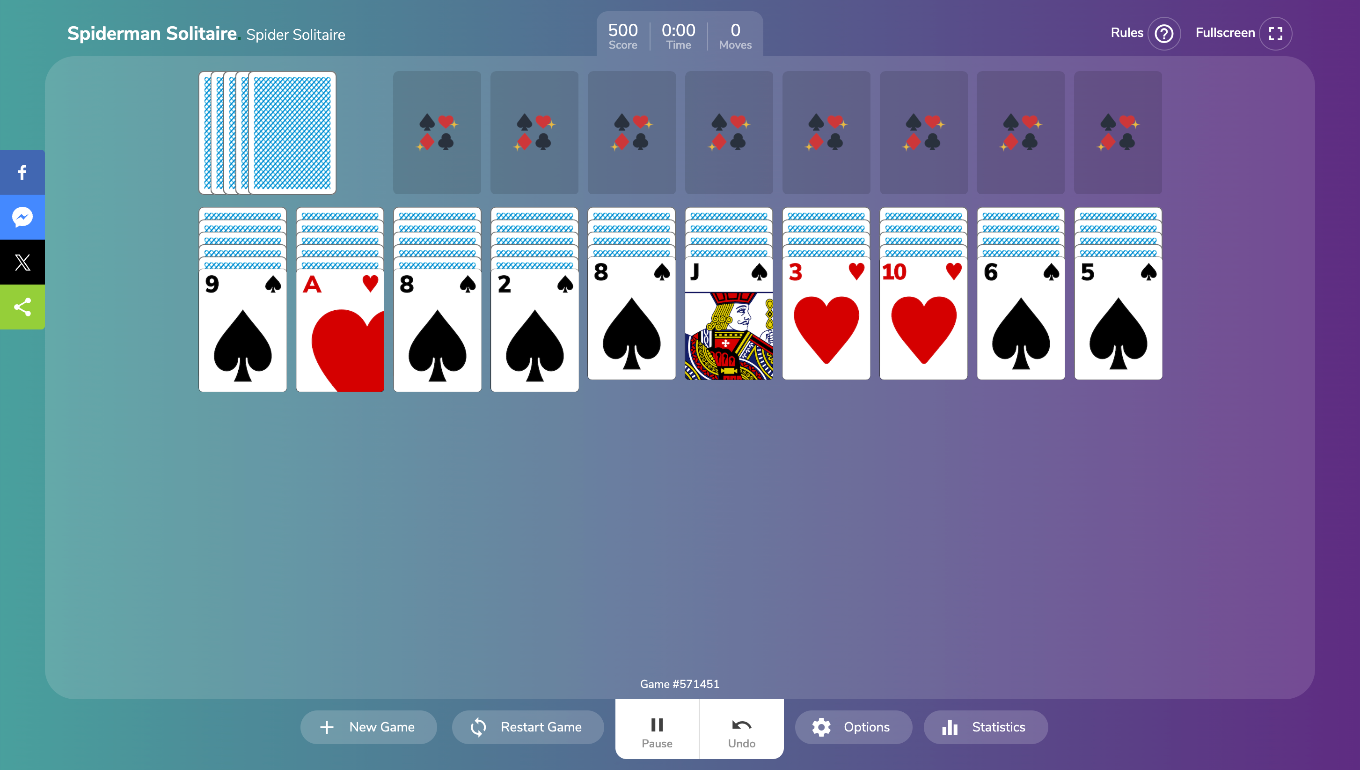SPIDERMAN SOLITAIRE

Frequently Asked Questions
-
How do you play Spiderman Solitaire?
Spiderman Solitaire uses 104 cards (2 decks) arranged in 10 tableau columns. Your goal is to build 8 complete sequences from King to Ace in matching suits. Place cards in descending order on the tableau - any card can go on a card one rank higher. However, only same-suit sequences can move together as a unit. When you complete a King-to-Ace sequence in one suit, it automatically moves to a foundation pile. Win by filling all 8 foundations.
-
What are the difficulty levels in Spiderman Solitaire?
There are three difficulty levels: 1 Suit (beginner) uses only spades with a 52% win rate, 2 Suits (intermediate) uses spades and hearts with a 16.6% win rate, and 4 Suits (expert) uses all four suits with only a 6.2% win rate. Start with 1 Suit to learn the mechanics, then progress to harder variations as your skills improve.
-
What is the best strategy to win Spiderman Solitaire?
Focus on these key strategies: Always prioritize revealing face-down cards to increase your options. Create empty columns early for flexibility and fill them with high-ranking cards like Kings. Build same-suit sequences whenever possible since they can move as units. Avoid using the stockpile until all tableau moves are exhausted. In multi-suit games, start mixed-suit sequences on higher cards to allow longer runs.
-
Can you move cards of different suits together?
You can place cards of different suits on top of each other in descending order (example: 7 of clubs on 8 of hearts). However, only same-suit sequences can be moved together as a group. If you create a mixed-suit stack like 9-spades, 8-hearts, 7-spades, you can only move the top cards individually. This rule makes suit management critical in 2 and 4 Suit variations.
-
How many times can you deal from the stockpile?
You can deal from the stockpile exactly 5 times during a game. Each deal places one card face-up on each of the 10 tableau columns, adding 10 cards total. You cannot deal if any column is completely empty - all columns must have at least one card. Use stockpile deals sparingly as they can block critical cards and limit your options.
-
What should you do with empty columns?
Empty columns are extremely valuable in Spiderman Solitaire. Use them for temporary card storage when rearranging sequences. Always fill empty columns with Kings or other high-ranking cards to maximize building potential. Never waste an empty column on low cards like 2-5, as this severely limits how many cards you can sequence. Empty columns give you the flexibility to separate mixed-suit stacks and create same-suit sequences.
-
Are all Spiderman Solitaire games winnable?
No, not all games are winnable. Experts estimate approximately 90-95% of deals have at least one solution, but finding that solution may be extremely difficult. Win rates vary dramatically by difficulty: 1 Suit has 52% actual wins, 2 Suits has 16.6%, and 4 Suits only 6.2%. Even unwinnable games provide valuable practice for pattern recognition and strategic thinking.
-
Why is it called Spider Solitaire?
The game is called Spider Solitaire because spiders have 8 legs, which corresponds to the 8 foundation piles you must complete to win. Each foundation pile represents one 'leg' of the spider. The game requires building 8 complete King-to-Ace sequences in matching suits. This thematic connection has made the spider name instantly recognizable among solitaire enthusiasts worldwide.
-
Should you use the undo button in Spiderman Solitaire?
Yes, the undo button is one of your most valuable tools. Use it to explore different move possibilities without penalty, correct mistakes, test various strategies, and learn optimal solution paths. Undo helps you understand why certain moves work better than others. It's especially useful when learning the game or attempting difficult 4 Suit variations. Don't view it as cheating - it's a learning tool that helps you become a better player.
-
When should you deal new cards from the stock?
Only deal from the stock when you have completely exhausted all moves in the tableau. Before dealing, ensure you've revealed as many face-down cards as possible, built all available same-suit sequences, and used empty columns strategically. The stockpile should always be your last resort because each deal adds 10 cards that can potentially block critical cards and create difficult situations.

